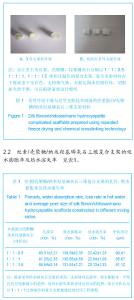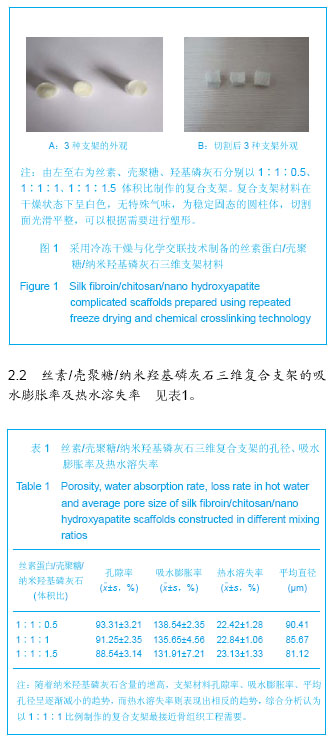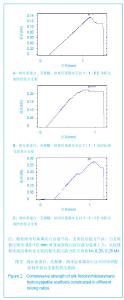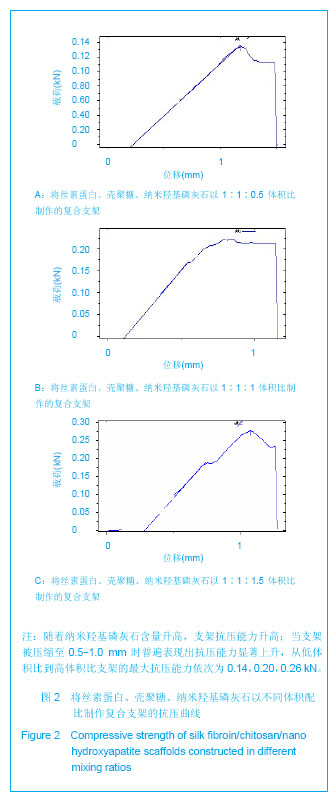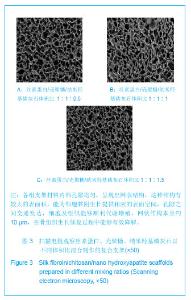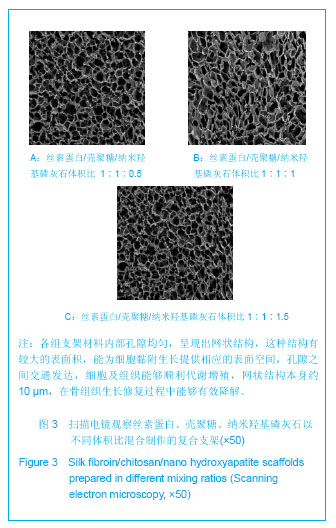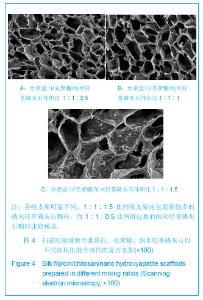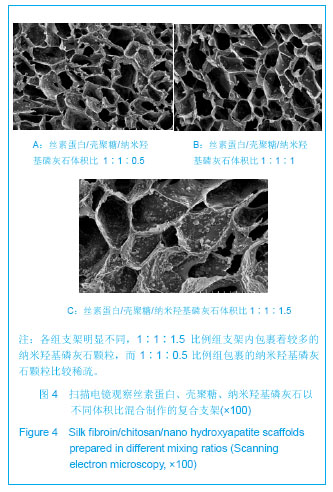| [1] 苗宗宁,李芳,张学光,等.丝素蛋白材料复合骨髓间充质干细胞修复皮肤创面[J].中国组织工程研究,2012,16(51):9616-9623.[2] Park SY,Ki CS,Park YH,et al.Electrospun silk fibroin scaffolds with macropores for bone regeneration: an invitro and in vivo study.Tissue Eng Part A,2010;16(4):1271-1279. [3] Zhang K,Mo X,Huang C,et al.Electrospun scaffolds from silkfibroin and their cellular compatibility.J BiomedMater Res A.2010;93(3):976-983. [4] Liu H,Li X,Zhou G,et al.Electrospun sulfated silk fibroin nanofi-brous scaffolds vascular tissue engineering. Biomaterials.2011;32(15):3784-3793.[5] Ghaznavi AM,Kokai LE,Lovett ML,et al.Silk fibroin conduits: a cellular and functional assessment of peripheral nerve repair.Ann Plast Surd. 2011; 66(3): 273-279. [6] 田旭,张福江,闸世康.蚕丝组织工程肌腱修复肌腱缺损的实验性研究[J].中国矫形外科杂志,2010,18(4):316-318. [7] Liu H,Ge Z,Wang Y,et al.Modification of Sericin-free Silk Fibers for Ligament Tissue. Engineering Application.J Biomed Mater Res H Appl Biomater.2007;82(1):129-138.[8] 刘小华,邱伟,李舒梅,等.低蛋白壳聚糖神经导管组织相容性的实验研究[J]. 实用医学杂志,2011,27(8):1359-1361.[9] Choi SW,Xie J,Xia Y.Chitosan-based inverse opals: Three- dimen- sional scaffolds with uniform pore structures for cell culture.Adv Mater Deerfield.2009;21(29): 2997-3001. [10] Lahiji A,Soh rabi A,Hungefford DS,et al.Chitosan supports the expression of extracellu larm atrixproteins in human ostcoblasts and chondrocytes. J Biomed Mater Res.2000; 51(4): 586-595. [11] 张文元,杨亚冬,房国坚.壳聚糖-丝素复合支架材料与骨髓间充质干细胞相容性的研究[J].中国卫生检验杂志,2010,20(12):3084-3086. [12] 朱伟民,王大平,孟志斌,等.纳米羟基磷灰石人工骨修复骨缺损的实验研究[J].中国临床解剖学杂志,2006,24(6):670-673.[13] Pezzatini S,Morbidelli L,Solito R,et al.Nanostructured HA crystals up-regulate FGF-2 expression and activity in microvascular endothelium promoting angiogenesis. Bone. 2007;41(4):523-534. [14] 李楠竹,郭氧,尤元璋.骨盆截骨术治疗小儿先天性髋关节发育不良[J].实用骨科杂志,2010,16(8):582-584. [15] 段宏,张开伟,闵理,等.纳米羟基磷灰石/聚酰胺66骨填充材料修复肢体良性骨肿瘤术后骨缺损的疗效分析[J].中国骨与关节外科,2009,2(5):341-346.[16] Wang G,Zheng L,Zhao H,et al.In vitro assessment of the differentiation potential of bone marrow-derived mesenchymal stem cells on genipin-chitosan conjugation scaffold with surface hydroxyapatite nanostructure for bone tissue engineering.Tissue Eng Part A.2011;17(9/10):1341-1349.[17] Venkatesan J,Kim SK.Chitosan composites for bone tissue engineering-an overview. Mar Drugs.2010;8(8):2252–2266.[18] Tigli RS,Cannizaro C,Gumusderelioglu M,et al.Chondrogenesis in perfusion bioreactors using porous silk scaffolds and hESC-derived MSCs.J Biomed Mater Res A. 2011;96(1): 21-28.[19] Peng F,Yu X,Wei M.In vitro cell performance on hydroxyapatite particles/poly/L-lactic acid nanofibrous scaffolds with an excellent particle along nanofiber orientation. Acta Biomater.2011;7(6):2585-2592. [20] 佘荣峰,邓江,黄文良,等.丝素蛋白/壳聚糖三维支架材料的制备方法[J].中国组织工程研究与临床康复,2011,15(47): 8821-8824.[21] Shavi GV,Nayak UY,Reddy MS,et al.Sustained release optimized formulation of anastrozole -loaded chitosan microspheres: in vitro and in vivo evaluation.J Mater Sci Mater Med.2011;22(4): 865-878. [22] Li FQ,Ji RR,Chen X,et al.Cetirizine dihydrochloride loaded microparticles design using ionotropic cross- linked chitosan nanoparticles by spray-drying method.Arch Pharm Res.2010; 33(12):1967-1973. [23] Myeroff C,Archdeacon M.Autogenous bone graft: donor sites and techniques. J Bone Joint Surg Am.2011;93(23): 2227- 2236. [24] Mouriño V,Boccaccini A.Bone tissue engineering therapeutics: controlled drug delivery in three-dimensional scaffolds.J R Soc Interface. 2010;7(43):209-227.[25] Chen M,Le DQ,Baatrup A,et al.Self-assembled composite matrix in a hierarchical 3-D scaffold for bone tissue engineering.Acta Biomater.2011;7(5):2244-2255.[26] Moutos FT,Guilak F.Functional properties of cell-seeded three-dimensionally woven poly(epsilon- caprolactone) scaffolds for cartilage tissue engineering.Tissue Eng Part A 2010;16(4): 1291-1301.[27] 朱现玮, 徐卫袁,张兴祥,等.多孔型丝素蛋白/羟基磷灰石复合骨髓间充质干细胞修复兔半月板无血运区软骨损伤[J].中国组织工程研究,2012,16(29):5375-5378. [28] Zhao Q,Yin J,Feng X,et al.A biocompatible chitosan composite containing phosphotungstic acid modified single-walled carbon nanotubes.J Nanosci Nanotechnol. 2010;10(11):7126-7129.[29] Costa-Pinto AR,Reis RL,Neves NM.Scaffolds based bone tissue engineering: the role of chitosan.Tissue Eng Part B Rev.2011;17(5): 331-347.[30] Budiraharjo R,Neoh KG,Kang ET.Hydroxyapatite-coated carboxymethyl chitosan scaffolds for promoting osteoblast and stem cell differentiation.J Colloid Interface Sci.2012; 366(1):224-232. |
